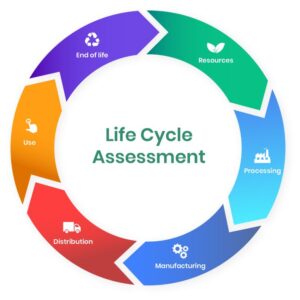Life Cycle Assessment (LCA) – A Way to Sustainable Reporting and Business

Every individual in the industry holds a whole life responsibility. We must be conscious that our actions will have unexpected consequences, and it is our responsibility to evaluate the entire scope of the consequences. LCA can help us design a more sustainable and equitable future by approaching our work with consciousness.
What is a Life Cycle Assessment (LCA)?
A Life Cycle Assessment (LCA) is defined as the systematic analysis of the potential environmental impacts of products or services during their entire life cycle.
During a Life Cycle Assessment (Life Cycle Analysis), you evaluate the potential environmental impacts throughout the entire life cycle of a product (production, distribution, use and end-of-life phases) or service. The International Organization for Standardization provides guidelines and requirements for conducting a Life Cycle Assessment according to ISO 14040 and 14044.
What are the main phases of a Life Cycle Assessment?
The Main Phases of Life Cycle Assessment includes:
- Goal & Scope Definition
In this phase, you define the product or service that you wish to assess, you choose a functional basis for comparison, and you define the required level of detail. You then set a goal which determines the scope, including objective, application and audience. Lastly, you determine whether or not there has to be a critical review of that goal.
- Inventory Analysis
Here you perform a data compilation and an inventory analysis of extractions from and releases into the environment. The final inventory provides a list of all inputs and outputs associated with the life cycle of your product or service.
- Impact Assessment
In impact assessment, you classify resource use and emissions generated according to their potential impacts and quantify them for a limited number of impact categories, which you may then assess in terms of their relative importance for the goal of the LCA study.
- Interpretation
With the above information, you discuss the results in terms of contributions, relevance, robustness, data quality and limitations, and you systematically evaluate any opportunities for reducing the negative effects of the product(s) or service(s) on the environment while avoiding burden shifting between impact categories or life cycle phases. Avoiding burden shifting is a core strength of the LCA approach.
What are the benefits of conducting LCA?
The results of an LCA can help businesses, policymakers, and other organizations make more informed decisions to advance towards sustainability. It provides critical data that can support the following:
- process and product-design improvement
- marketing (e.g., backing up environmental claims or meeting consumer demand for green products)
- hot-spot analysis to facilitate continuous improvement.
- third-party verification or certification
- method for quantifying key environmental impacts (e.g., greenhouse gas, carbon emissions, water use, and energy consumption)
- goal setting for climate-change and other sustainability policies
Life Cycle Assessment and Reporting
There is a growing demand for companies to report their environmental impacts and planned and completed sustainability actions. With LCA studies comparing the situation before and after specific changes have been implemented, companies can show how much progress has been made compared to a benchmark or target. Alternatively, they can simulate the impact of planned changes. There is a multitude of reporting standards outlining what needs to be reported. LCA is a methodology that can bring numeric substance into that reporting, regardless of which reporting framework is applied.
Who can use an LCA to make decisions?
While company owners and top leadership set sustainability targets, the concrete actions leading to improvements often need to be defined in various parts of the organization. Therefore, there are several functions in a company where LCA results are relevant. The design stage most often creates the most significant impact on life cycle emissions. In this stage, materials and maybe suppliers are selected. Because of this, the R&D department is one where LCA would be useful as an input to decision making.
Another obvious function is procurement. With the help of an LCA model, a what-if analysis can be made, comparing the impact of using different vendors from e.g., different geographies or using different production methods for the same raw material. Both inbound and outbound logistics can also have a significant role, depending on the proportional impact of transportation on the full life cycle impacts.
#LCA #lifecycleassessment #socialimpact #LCAmodel #LCAdatabase #LCAanalysis #EnvironmentalImpact #Sustainability #LCAtools #EnvironmentalResponsibility #SustainableBusiness
